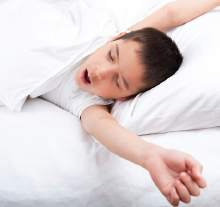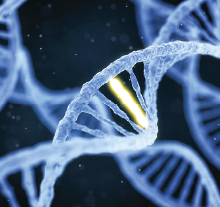Journal Digest
Migraines Triple the Odds of Anxiety Disorder

Adults who have migraines have three times the prevalence of generalized anxiety disorder (GAD) compared with adults who are migraine-free, reports a new study appearing in the journal Headache.
The study also found that among people with migraines, men had a higher risk of GAD than women—the opposite of what is seen in the general population.
“It is unclear what might cause the increased vulnerability among men with migraines to have higher odds of GAD in comparison to women with migraines,” wrote Esme Fuller-Thomson, Ph.D., of the University of Toronto and colleagues. “This may be a result of the fact that men are less likely than women to take medication to treat their migraine and therefore the disorder may be more painful and less controllable, which could result in anxiety. In addition, among those with migraines, men are more likely to report depression than women.”
The researchers analyzed data contained in the 2012 Canadian Community Health Survey–Mental Health (CCHS-MS), including 2,232 adults who reported experiencing migraines and 19,270 with those who did not.
The researchers found adults aged 20 and older who reported migraines have a greater prevalence of past year GAD (6 percent versus 2 percent).
Besides being male, low income, having a university degree, and not having someone to talk to about important decisions were also associated with higher odds of anxiety in people with migraines. People who did not list having an “advisor or confidant to discuss important matters” had around five times the risk of anxiety, the authors reported. This connection shows how social support can play an important protective role in the mental health consequences of chronic pain disorders.
Fuller-Thomson E, Jayanthikumar J, Agbeyaka S. Untangling the Association Between Migraine, Pain, and Anxiety: Examining Migraine and Generalized Anxiety Disorders in a Canadian Population Based Study. Headache. 2017; 57(3):375-390.
IPT Found Effective for Patients With Sexual Trauma History

Patients who have a history of sexual trauma may be more likely to respond to interpersonal psychotherapy for posttraumatic stress disorder (PTSD) than other common psychotherapies, according to a study published April 4 in Depression and Anxiety. The findings suggest that helping patients to build trust in the aftermath of a trauma may be particularly beneficial for patients who have been victims of sexual assault.
John C. Markowitz, M.D., a research psychiatrist at the New York State Psychiatric Institute, and colleagues compared the outcomes of 110 unmedicated patients who had chronic PTSD and a score >50 on the Clinician-Administered PTSD Scale (CAPS) and were assigned to three types of therapy over a 14-week period: weekly interpersonal psychotherapy (IPT), prolonged exposure (PE: standard, reference treatment), or relaxation therapy (RT: active control condition).
As was previously reported in the American Journal of Psychiatry, the authors found IPT had a higher response rate (defined as >30 percent CAPS reduction) than RT (63 percent vs. 38 percent), and nonsignificantly lower dropout than competing treatments (IPT=15 percent, PE=29 percent, RT=34 percent). Among patients with comorbid major depressive disorder (MDD)—50 percent overall—PE dropout trended higher than in IPT.
Thirty-nine (35 percent) patients in the trial reported sexual trauma, 68 (62 percent) reported physical trauma, and 102 (93 percent) interpersonal trauma. Baseline CAPS scores did not differ by the presence or absence of trauma types, the authors noted in the current report. “Although all therapies had equal efficacy among patients without sexual trauma, sexually traumatized patients [had less positive outcomes] in PE and RT than in IPT,” they wrote.
Markowitz JC, Neria Y, Lovell K, Van Meter PE, and Petkova E. History of Sexual Trauma Moderates Psychotherapy Outcome for Posttraumatic Stress Disorder. Depress Anxiety. April 4, 2017. [Epub ahead of print]
Children With Sleep Apnea May Be At Risk of Developmental Delays

Children with moderate or severe sleep apnea show noticeable reductions in gray matter in several areas of the brain that control cognition and mood, according to a study appearing in Scientific Reports.
“Regardless of the origin of these volume reductions, altered regional grey matter is likely impacting brain functions, and hence cognitive development potential may be at risk in children with OSA [obstructive sleep apnea],” the authors wrote. The findings reinforce the importance of early detection and treatment of this common sleep disorder.
For this study, which was published on March 17, researchers took high-resolution MRI scans of 16 children aged 7 to 11 with OSA and nine matched controls without OSA. In addition to the scans, the children had their sleep patterns evaluated in a sleep laboratory and were given neurocognitive tests.
The researchers compared the brain scans of children with OSA to those without OSA. (The brain scans of 191 healthy children from the Pediatric MRI database were also included in the analysis). They found that children with OSA had less gray matter in the frontal and prefrontal cortices, parietal cortices, temporal lobe, and the brainstem The changes in brain volume were not related to the severity of the sleep apnea as measured in the sleep lab, nor to the children’s neurocognitive scores.
“The mechanisms underlying such extensive MRI changes, the exact nature of the gray matter reductions, and their potential reversibility remain virtually unexplored and should prompt intensive future research efforts in this direction,” the study authors concluded.
Philby M, Macey P, Ma R, et al. Reduced Regional Grey Matter Volumes in Pediatric Obstructive Sleep Apnea. Sci Rep. March 17, 2017; 7:44566.
Suicide Risk After Violent Attempt Found Highest in First 30 Days

An article published March 21 in AJP in Advance suggests that people who survive violent self-harm events, particularly those involving self-inflicted firearm injuries, are at the greatest risk of suicide in the 30 days following the initial self-harm event.
For the study, Mark Olfson, M.D., M.P.H., and colleagues extracted Medicaid data on adults aged 18 to 64 with clinical diagnoses of deliberate self-harm (n=61,297). The self-harm cohort was followed forward from the index date for 365 days, date of death from any cause, or end of available data, whichever came first. A total of 243 deaths by suicide took place during the follow-up period.
The researchers reported that during the first year following the index self-harm event, the suicide rate for the follow-up cohort was 439.1 per 100,000 person-years—37 times greater than the suicide rate of the U.S. general population (11.8 per 100,000 person-years).
Self-harm patients who used violent methods were at a 17-fold increased risk of suicide during the first 30 days after the initial event compared with those who used nonviolent methods, but not during the following 335 days.
“This risk pattern supports concerted efforts to protect patients who attempt suicide by highly lethal methods during the acute period after the self-harm event. During periods of extremely high risk, inpatient admission may facilitate crisis work, intensive supervision, and implementation of complex interventions, and it can help ensure patient safety,” the authors wrote. “For patients who own firearms or live in homes with firearms, distributing trigger locks and urging family members to temporarily store household firearms away from the patient’s home can be a lifesaving intervention.” ■
Olfson M et al. Suicide Following Deliberate Self-Harm. Am J Psychiatry. March 21, 2017. [Epub ahead of print]
Similarities in Gene Expression Seen for Chronic Pain and Depression

Chronic pain affects more than 100 million people in the United States, and many of these people have comorbid depression. A study published in Science Signaling has now pinpointed molecular changes in the brain that could link these two ailments.
Researchers used a mouse model of pain to monitor gene expression in three areas of the brain: the nucleus accumbens, the medial prefrontal cortex, and the periaqueductal gray. They identified hundreds of genes that significantly changed expression in response to chronic pain in all three regions, including 39 genes that had previously been implicated in depression, anxiety, and/or pain; nine of these genes have been linked with all three conditions.
One gene of interest uncovered was the cytochrome-family gene Cyp2e1; this gene, which is involved in alcohol metabolism and associated with depression, showed reduced expression in all three brain regions.
The researchers also analyzed the gene expression in a mouse model of chronic stress, which mimics human depression. This revealed eight genes that were regulated in a similar manner in response to stress and pain, including another gene, Capn11, that was altered in all three brain regions. ■
Descalzi G, Mitsi V, Purushothaman I, et al. Neuropathic Pain Promotes Adaptive Changes in Gene Expression in Brain Networks Involved in Stress and Depression. Sci Signal. March 21, 2017; 10(471). pii: eaaj1549.



